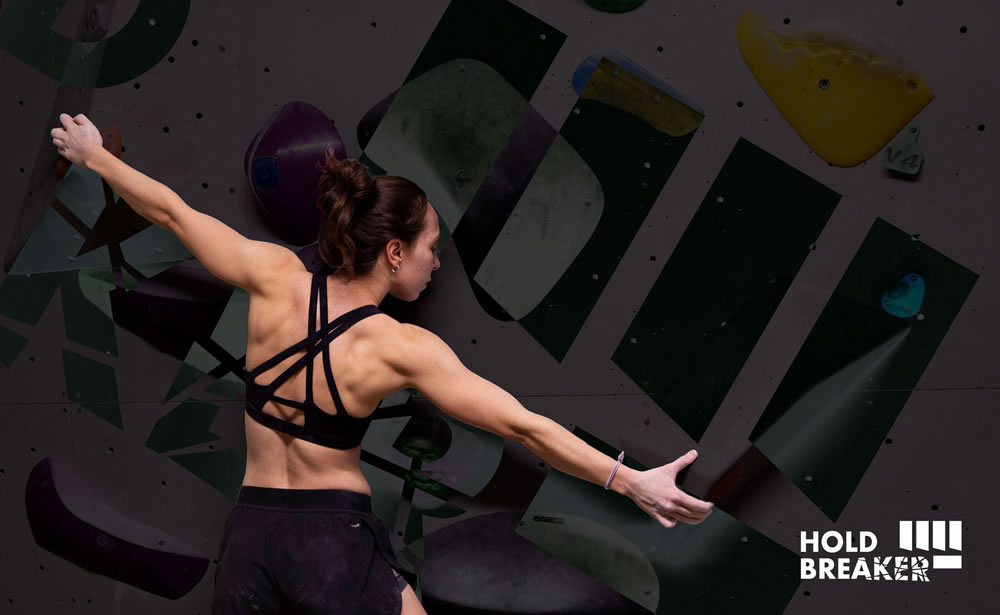Sponsored Content
Holdbreaker is a climbing company run by women, designing gender-specific products for all forms of ascent. In this article, they discuss the issue of climber's physique, how climbing shapes our bodies, and specifically, what that means when you're looking at the Holdbreaker X (their new climbing bra). Holdbreaker are also building a community, where beginners and experienced climbers can get together to teach and learn, to encourage one another and feel inspired.
With every gym session, every afternoon at the crag, every “try hard” move, and even those routes we project but never quite manage to send, we get stronger. Our muscles grow - especially those in our back, arms, shoulders, and chest. This strength gain and muscle growth is exciting and totally welcomed. All of the time spent on the wall changes our bodies for the better. We become stronger and healthier. Our climbing skills improve and routes that used to be a challenge are now a warm-up. With this progress comes stronger grip, and an understanding that our hands are never going to be soft again, but forever calloused. Years of climbing or even months will change our bodies and in turn, change the way clothes fit.

Which Muscles Develop With Climbing
Sticking to the wall for an extended period of time is a whole-body workout. Remember back to the initial days of climbing when you grasped the rock like it was the last cookie you’ll ever get to eat? When each movement felt strained? Those were the days of learning that legs are a huge part of climbing. Along with leg and bum strength, the biggest changes come in the core and the upper body.
The latissimus dorsi muscles, the lats, are the “wing” muscles. They run along the outer sides of the back starting at the armpit ending at the hip. These are basically our “pull-up” muscles, the ones that help us get to the top of that route.
Our shoulders also widen, with the deltoid muscle getting stronger. The delts grow outward, giving us more pronounced shoulders than we had before climbing.
Our core muscles in the abdominals strengthen especially with roof or steep overhang climbs. Even on slab we’re engaging core muscles to make sure we’re holding as close to the wall as possible. Slab slips are always terrifying. Forearms also turn into brick strength, but continue to burn no matter how strong or many years of climbing we have under our belts.
As the years progress, these muscles develop further, becoming more defined and chiseled. It may not always feel like it, but climbing is absolutely a full-body and cardio workout so we see the same benefits as other cardio exercises bring, like a lower body fat percentage.
How We’re Different From Other Athletes
Our physique is significantly different from other athletes like yogis, boarders or runners. A main difference in is our backs and chests. Climber’s lats lead to a signature broad back, and it’s one we should be proud of. We worked hard for those muscles! While yoga and boarding both have significant upper body strength, the lats don’t develop quite as much as with intense and frequent climbing. Runners tend to develop a long and lean muscle. They have abs of steel, chiseled legs and arms, but they lack the broad back, shoulders and chest that comes with “I refuse to pop off this 5.8 so try harder”.
The thing about climbing is that it’s rarely ever a repetitive motion, like cycling, running, swimming or even lifting weights. Climbing is unique each time we scale up the wall; even if we’re on the same route, we might pick a different beta. There’s the crimpy problems, the always frightening slab, the huge jugs on overhangs or the endless traverse that burns hands and forearms equally. We’re always working on muscle growth in all sorts of ways, never just one repetitive motion, and our body’s strength reflects this diversity of movement.
The Downfalls of a Climber’s Physique
While ticking those projects, increasing the grade we can send, and getting stronger with each move, we do run the risk of injury. The simple fact is climbing is a unique exercise - one where we’re holding up all of our body weight for extended periods of time. Not many other sports or hobbies can say the same. There’s a ton of pressure on our wrists, elbows, fingers, and shoulders. Even our necks can get sore from a day of overhang climbs. It’s important to listen to your body and take care of any pains as they arise so they don’t end up as lingering injuries. Practicing yoga is an excellent way to stretch and strengthen the muscles we use while climbing.
Often climbing-specific muscles dominate while others don’t get much of a workout. Practicing antagonistic exercises can help prevent common climbing injuries. These exercises work opposing muscles that don’t get as much of a workout while climbing. For example, the biceps are constantly worked while climbing while the triceps might not get so much attention. To counter for this, tricep-strengthening exercises will balance out arm strength and make for a much stronger arm overall. Tricep strength also takes pressure off the elbow joint. With climber’s elbow being a prominent and nagging climbing injury, performing an antagonistic exercise to get triceps strength will help prevent this. Push-ups (in proper form) are great for this. Deadlifts and wrist extensor-ups are also antagonist exercise you should become good friends with. When climbing, take a second to feel which muscles are working really hard. Once you’re off the wall, work on strengthening the antagonistic muscles. Doing this will help prevent injury as your climbing skills and climbing muscles grow.

Why Clothes Become Uncomfortable
Shopping for clothing with a climber’s physique can be discouraging. That stunning dress that zips up the back? It’ll zip up halfway on a female climber’s back. A button-up shirt is likely going to be re-enacting a movie scene where the superhero flexes and the buttons shoot across the room. And that tank with the built-in bra fits everywhere except for the bra part where it feels like a corset from the Victorian era. All of these clothes probably fit from about the belly button down, but the upper half is harder to fit.
The clothing we used to wear before climbing became a passion probably don’t fit right anymore. Because back, chest and arm muscles have grown while boob size hasn’t or has even decreased, it’s tough to find clothing that fits the upper half comfortably. Sizing up to get the right chest/back size often means the rest is too baggy and looks sloppy.
We also get back bulge from bras and sports tanks. This ill-fitting nature of bra bands is dreaded among female climbers. It’s just like a muffin top, only it slices into the lats, creating a back bulge above the top bra band. These bras also usually cut into the tops of our shoulders, leaving painful red marks. We’re strong women, and we work hard to nail those dynos and stick to the wall despite swinging into a barn door. Our strong muscles shouldn’t mean clothes no longer fit.
Which Clothes Fit
With broader than average back, shoulders, and chest, female climbers can find solace in looser-fitting tops. Styles that are flowy work better, and so do fabrics with some stretch to them. That’s especially important when looking for clothes to climb in. It’s never a great feeling in the middle of a multi-pitch day when you realise your shirt seams are ripping apart. Clothes that will work well for climbing should be durable and well-made so seams don’t start to rip under excess pressure. Bras and tops that have a “V” shape to them will be more comfortable. With a wider top band than lower band, the “V” shape ensures there’s enough room for lats and pectoral muscles while moving around on a route. Since climbing is an all-over cardio workout, it’s nice to feel like a top gives us enough room to breathe. Muscles work a whole lot better with oxygen supply. Above all else, climbing clothes should be comfortable to move in, all day long.

Follow Holdbreaker on Instagram or visit their website.



